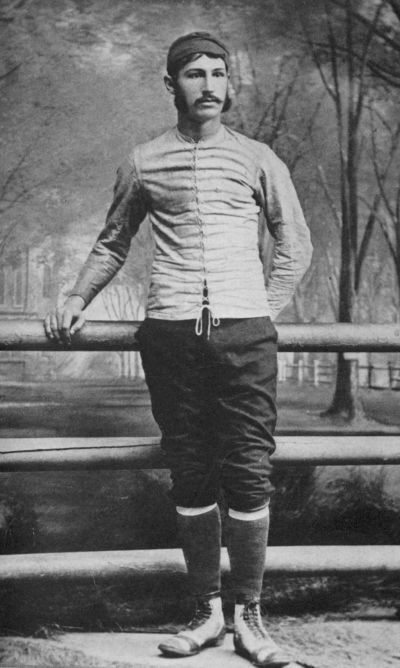 |
| Slightly less straightforward than it appears. |
The reality is that all versions of football have similar roots, and were adapted dependent on the preferences of small groups of people around the middle-late 19th century. With association football being founded in the private schools of England, namely Winchester, Harrow and Eton. And gridiron variants being a mix of rugby rules, imported from McGill University in Canada (originally from Rugby), and the already popular variants on association football being played by Harvard, Yale and Princeton.
The connection between the games is closer than it seems today, as the idea of having 11 players on each
 |
| Rutgers team -1882 |
When this is all combined, it made for the travelling Etonians to be much more comfortable with the game than our modern day players would be. And it may have stayed that way, but for the small group of representatives that organised an intercollegiate football convention to discuss organised games, and agree on a standardised set of rules. The first set of rules they came up with read as follows;
- The ground shall be 400 feet long and 250 feet broad.
- The distance between the posts of each goal shall be 25 feet.
- The number for match games shall be 20 to a side.
- To win a game 6 goals are necessary, but that side shall be considered victorious which, when the game is called, shall have scored the greatest number of goals, provided that number be 2 or more. To secure a goal the ball must pass between the posts.
- No player shall throw or carry the ball. Any violation of this regulation shall constitute a foul, and the player so offending shall throw the ball perpendicularly into the air to a height of at least 12 feet and the ball shall not be in play until it has touched the ground.
- When the ball passes out of bounds it is a foul, and the player causing it shall advance at right angles to the boundary line, 15 paces from the point where the ball went, and shall proceed as in rule 5.
- No tripping shall be allowed, nor shall any player use his hands to hold or push an adversary.
- The winner of the toss shall have the choice of the first goal, and the sides shall change goals after every successive inning. In starting the ball it shall be fairly kicked, not "babied", from a point 150 feet in front of the starter's goal.
- Until the ball is kicked no player on either side shall be in advance of a line parallel to the line of his goal and distant from it 150 feet.
- There shall be two judges, one from each of the contesting colleges, and one referee; all to be chosen by the captains.
- No player shall wear spikes or iron plates upon his shoes.
- In all matches a No. 6 ball shall be used, furnished by the challenging side and to become the property of the victor.
By all accounts these rules put the early "Boston Game" more in line with association football, although with a few distinct traits. It wasn't until the 1880's when the game started transforming into a recognisable form of the game. This was thanks to the afore mentioned McGill University, introducing the schools to the game of rugby [football]. It didn’t take long for this early form of rugby to superseed the kicking-based game as the primary sport at these colleges.
The rugby game of the time would term todays “try” as exactly that, an opportunity to try and score from a free kick, just as the colleges had been playing with their association style game, and the touchdowns. At the time these touchdowns were physically touching the ball down behind the line, and as with rugby it was merely for a try at scoring a goal. The players at these colleges prefered the Rugby variation on their game so
 |
| Our Man: Walter Camp |
The big shift came when the intercollegiate football convention brought in a fresh face, a man named Walter Camp, to whom we can attribute the ideas that drove us towards the modern game. Right from the outset Camp saw the goal of this commitee to improve the game, and not just maintain the status quo. This philosophy lives on in todays game, as there are yearly revisions to the rules.
At this time in the late 1870’s, the game of rugby was dominated by the scrum. These days a scrum is simply one means of getting the ball into play, but at the time it was the main way in which the ball was played. This was due to the prohibitive laws surrounding carrying the ball. By all accounts, this early version of Rugby football was just a more violent rendition of the association game.
I'm going to continue the dive into the origins of our game by continuing the chronicles of Walter Camp, and what he did for the game. However, I feel this is probably enough for one blog post. I'll leave you with a quote from an academic by the name of Stubbes on the subject of football in the 16th century; "Is this murthering play an exercise for the Sabbath day?"
